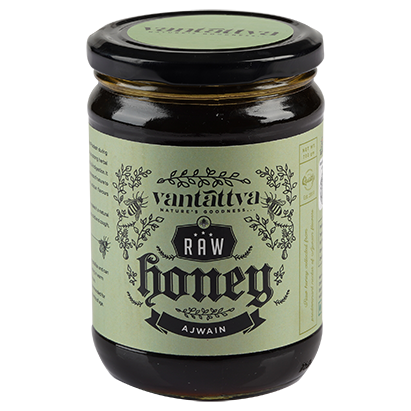FAQs
The benefits of honey are innumerable as it not only helps in weight management* but also in many other things as well. For example, if you are suffering from cold and cough, mix some ginger and honey and consume the mixture daily. The mixture will act as an antioxidant and will cure your illness naturally.
Grab a bottle of Vantattva Honey today!
Shopping Information
1. What makes Vantattva honey pure and trustworthy?
Our honey begins its journey in pristine forests and remote landscapes, where bees forage freely on seasonal flowers. We harvest it only when fully ripe, allowing it to develop its own story in every jar. Every step — from careful extraction to gentle storage — is done without heat or harsh processing, so the honey you receive is pure and authentic.
2. Why do you sell only raw honey?
At Vantattva, we believe honey is at its best when untouched by heat or heavy processing. Raw honey preserves the natural enzymes, antioxidants, pollen, and aroma that give it its full nutritional and medicinal value.
By selling only raw honey, we ensure that every jar delivers nature’s pure goodness exactly as the bees intended, offering both authentic flavour and health benefits that processed honey simply cannot match.
3. Do you offer organic-certified honey?
Organic certification in India is granted only to honey collected from wild forest beehives. However, achieving this often involves disturbing bee colonies or using unhygienic harvesting methods, which can compromise hive health and honey quality.
At Vantattva, we choose a different path. We prioritize ethical, minimally invasive harvesting and ensure that our honey is raw, pesticide-free, single-origin, and nutrient-rich. While we do not hold formal organic certification, our honey naturally meets — and often exceeds — the purity and quality standards that such certification aims to guarantee.
This way, you get honey that is truly wholesome and ethically sourced, while protecting the bees and their environment.
4. Are your honey varieties blended or single-origin?
We believe every honey should tell the story of its region and season. That’s why we never blend varieties. Each jar is single-origin, capturing the unique flavour, aroma, and health benefits of flowers from its source. Our collection includes Himalayan Wild Forest, Sundarban Wild Forest, Sheesham, Ajwain, Mustard, Eucalyptus, and seasonal honeys — each with its own story to tell.
5. Does your honey crystallise?
Yes — our honey crystallises naturally, which is a true sign of purity. In India, there’s a common myth that crystallised honey is fake — this is false. Crystallisation happens because of natural sugars, floral sources, and storage conditions. If your honey crystallises, you can gently warm the jar in lukewarm water to return it to liquid form, taking care to avoid high heat so that all its natural goodness is preserved.
6. Are your honeys NMR tested, and how do you ensure their purity?
We take the purity and authenticity of our honey very seriously. Every batch undergoes rigorous laboratory testing for pesticides, antibiotics, heavy metals, and overall authenticity, along with verification of natural pollen and nutrients.
NMR testing, while a powerful tool, is not a mandatory compliance in India. To provide extra consumer confidence, we voluntarily conduct NMR testing on our highest-selling Himalayan Wild Forest Honey, in addition to our standard FSSAI-compliant quality checks. These measures ensure that every jar you receive is safe, pure, and truly representative of nature.
7. Why is Vantattva honey more expensive than regular honey?
Vantattva honey reflects authenticity, purity, and ethical harvesting, requiring care at every step — from sourcing nectar in pristine environments to manual extraction, minimal processing, and strict checks. Unlike mass-produced honey, we never blend varieties or compromise on quality, which naturally makes our honey premium in both price and purity.
8. Why isn’t Vantattva honey available on quick commerce platforms?
We are not mass producers and do not compete on speed or volume alone. Every jar undergoes multiple checks and balances to ensure purity and quality. By dispatching directly from our warehouse, we maintain full control over quality, ensuring every order meets our highest standards.
9. Why do colour, taste, and consistency vary between batches?
Every batch reflects the changing seasons, different flowers, and unique regions from which it is collected. These variations are a mark of authenticity, telling the story of each flower, forest, and season in every jar.
10. Are your products safe for children and adults?
Our honey and honeycomb are safe for adults and children over 1 year old. Children under 1 should avoid honey due to botulism risk. Each jar is crafted to provide wholesome goodness for your family.

